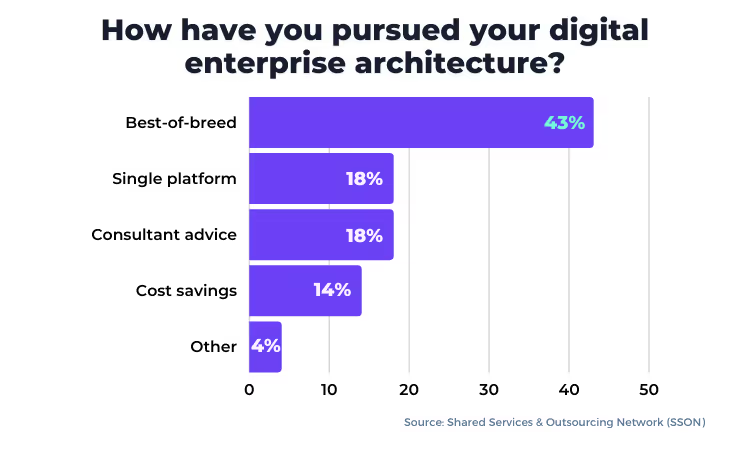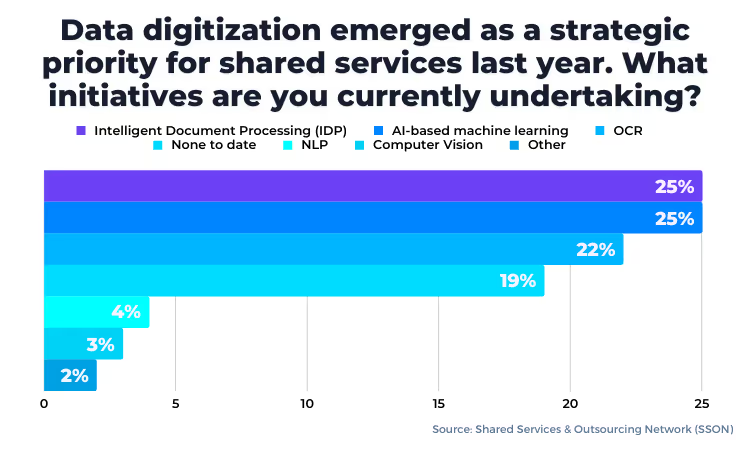

Economic and workforce pressures have increased the fever-pitch focus on digital transformation. And on the frontlines of enterprise transformation efforts you’ll typically find Global Business Services (GBS)—making the trends and concerns of GBS a bellwether for what’s working and what’s next across industries.
Which makes SSON’s latest report on intelligent automation (IA) in GBS and shared services (SSO) titled “The State of Intelligent Automation Global Market Report H1 2022: Integrating & Adopting AI in a Meaningful Way,” a source of valuable insight into where enterprises are at with intelligent automation, where they are going, and, perhaps most importantly, what’s holding them back.
The promise of intelligent automation is to make it possible for enterprises to automate more—and more complex—business process automation scenarios. And the advances in available IA technologies and platforms are making delivering on that promise a reality. Automation tools have evolved, expanded, merged, and become “table stakes” for digital transformation / the digital enterprise.
“While the RPA part of IA automated transactional work, additional capabilities like data digitization, machine learning, and artificial intelligence are exploding the scope of automation in today’s enterprise. As a result, IA is a critical driver of transformation. But only if the path is cleared for it to run smoothly.” –Barbara Hodge, Global Editor, SSON
But at the same time as IA appears to be coming into its prime with expanded and connected capabilities, the majority of organizations surveyed in the report still assess their level of automation within GBS/SSO as low or zero.

Integration used to be the barrier. How can an enterprise achieve end-to-end automation, let alone digital transformation, when digital technologies themselves are disconnected? While integrating easily, right out of the box, is now by far the norm, it remains a tie-breaker as enterprises lean away from platform solutions that “do it all” and toward integrating best-of-breed solutions to build out their digital enterprise tech stack.

Data complexity. It’s the thorn in the side of automation. One of the last remaining hurdles to digital transformation is the struggle to automate and scale business processes that involve unstructured data. Accurately processing data is the primary bottleneck to automating end to end. That’s why so many business processes still run on manual inputs and human intervention, even when automation tools are involved as well.
That’s why enterprises stand to gain immense value from processing unstructured data to close the remaining gap between the potential of intelligent automation and realizing that potential. So it’s encouraging to see SSON’s report shine a spotlight on the immense importance of unstructured data to the future of IA, highlighting that “the biggest opportunity for IA this year is the transition we are witnessing from structured to semi-structured and unstructured data processing.”
A year ago, data digitization emerged as the single biggest priority for GBS and shared services. This year, nearly 60% of respondents said their digitization efforts are well underway.
The road to digitizing data appears to be fragmented, however. Following the trend of selecting point solutions over platforms, GBS and shared services organizations are dabbling with different unstructured data processing tools and technologies.

The problem is, as separate tools, different AI-based technologies aren’t able to offer the breadth and quality of unstructured data processing that’s required to span all types of information formats, and reliably serve intelligent automation of business processes with the necessary data.
Today’s reality is that unstructured data remains the stumbling block for expanding intelligent automation within GBS and SSO (and beyond). Less than 1/5 of organizations are capturing and processing above 70% of their unstructured data.
The opportunity—and necessity—of transforming processes into end-to-end automated workflows is pushing GBS and SSO organizations to address the elephant in the room of unstructured data.
Unfortunately, organizations are still looking at processing unstructured data one data type/format at a time. It’s a little bit like the parable of several blind men attempting to identify an elephant, which is, of course, much more than the sum of its parts.

Looking at each unstructured data type on its own risks perpetuating the low automation levels already reported by GBS and SSO organizations. It’s no secret that scaling automation is the goal across every industry. Taking a holistic approach to processing unstructured data holds the key to breaking through the automation-at-scale barrier.
Even though integrating is the norm, for processing unstructured data a point-solution strategy risks draining resources while leading you down an inferior path. In a concluding interview with super.AI CEO Brad Cordova, the SSON report highlights the fact that organizations need not piece together AI solutions for data processing on their own.
“It used to take an army of data scientists to build AI solutions. Even then, most AI projects failed to produce ROI. Today, companies are creating AI platforms that can be set up by business users and deliver enterprise-grade AI applications for unstructured data processing in days, not months or years.” – Brad Cordova, CEO, Super.AI
Yes, integrating different AI tools together is possible. But you aren’t going to achieve the same results as with a unified unstructured data processing solution that combines multiple AI models all on its own, intelligently splitting up and funneling different aspects of unstructured information through the most effective processing path.
Super.AI offers the only solution that breaks down complex unstructured data in any format to route each component for best-fit processing – combining AI models, software, and human crowd processing – to deliver 100% data processing with guaranteed results.
.avif)


.svg)